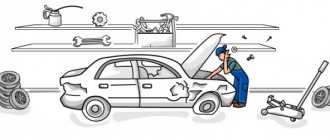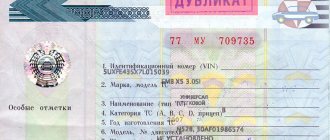Do you want to take a test based on the article after reading it?
Not really
When buying a new or used car, the happy owner is faced with a new question - whether to take out insurance for the purchased car or whether it is possible to drive it to their place of residence without it.
Legislation in this area is changing very quickly, so the driver risks getting into an unpleasant situation without knowing some of the nuances.
Normative base
Issues of car insurance in Russia are regulated mainly by two regulations - Federal Law No. 40 “On compulsory insurance of civil liability of vehicle owners” and the Traffic Rules.
The first of them establishes the very regulatory framework for the existence of compulsory motor liability insurance, and traffic rules clarify the application of the law regarding road traffic. In addition, there is administrative liability for violating the norms of the above-mentioned acts. This issue is regulated by the Code of Administrative Offenses.
At the same time, it should be noted that the norms of the first two regulations are in some contradiction with each other.
If the law on compulsory motor liability insurance gives the car owner the right to drive without insurance for five days, then the traffic rules strictly require the driver to have insurance and assume that he will be able to demonstrate it to the traffic police officer upon request.
As a result of this contradiction, the driver may be faced with a situation where they will try to apply the rules of the Code of Administrative Offenses on liability for the lack of compulsory insurance. Despite the fact that the owner of the car can rely on a provision of the law that gives him a ten-day right to drive without a policy, there are often cases when inspectors require a document and threaten fines based on paragraph 2.1.1 of the Rules.
Driving a car without an insurance policy
When a car passes from one owner to another, Federal Law No. 40 gives 10 days for the new owner to obtain compulsory motor liability insurance. But in order to get it, the car needs to be driven to the site for technical inspection. Since compulsory motor liability insurance must be issued even before registering the purchased car and taking into account the above contradiction, such a distillation may be a problem.
There are three ways to avoid unnecessary headaches when moving a car after a change of owner and before obtaining insurance:
- draw up a power of attorney or agreement for free use;
- the former owner can ride in the cabin with the new one;
- purchase temporary insurance.
The first two methods are used especially often. The first method involves the previous owner of the car drawing up a general power of attorney or agreement for the use of the car for the new one.
When drawing up a power of attorney, the duration of its validity must take into account the ten-day period established by law. To draw up a general power of attorney, you will also need to use the services of a notary, which are not needed if a use agreement is drawn up.
But still, both methods do not always eliminate unpleasant communication with traffic police officers. Therefore, it makes sense to purchase a transit insurance policy.
Car transportation by professional drivers
Driving cars across Russia
You don't have to buy a car every day. The cost and equipment of models in different regions differ greatly, and the distance of the place of purchase from the place of residence is not a serious obstacle for car enthusiasts. The owner himself can drive the car, but if this is not possible, the car is driven by professional performers.
Documents required to move a car
If a driver drives a vehicle over a long distance, he needs to have a number of documents with him. Their presence will protect him from accusations of breaking the law and will indicate that he is driving the car legally.
This list of papers is quite small:
- Driver's license.
- A document confirming the ownership of a car or ownership of it (PTS, power of attorney, agreement).
- Regular or transit MTPL insurance, if available.
The type of insurance that a car owner should carry with him depends on whether he has already taken out car insurance on a permanent basis or not. If we are talking about the period between acquiring ownership of a car and its registration, then temporary insurance is the most suitable option.
Penalties for drivers without compulsory motor liability insurance
They are usually punished by a fine:
- Got into an accident and don't have insurance? If you are the culprit of the accident, you will have to compensate for both your own and others’ losses. Was the accident not your fault? The damage will be compensated by the other driver or his insurance company.
- Every time you communicate with an inspector, you will have to explain why you do not have compulsory motor insurance and prove that the car is not stolen. The inspector has the right to detain you and clarify the details.
- The policy has been issued, but is not with you (lost, did not have time to issue it again)? You will be fined.
- You have insurance, but another person is driving, whose name is not on the policy? Again a fine.
- Drive with an expired policy or outside its validity period (for example, insurance was issued from May to September, but it is November) - you will be fined.
This is interesting: Standard contract for the provision of legal services
From November 15, 2014, the traffic police will not remove license plates from a car and does not have the right to evacuate a car to a impound lot if the driver does not have an insurance policy. In 2021, according to the new rules, the fine is the maximum penalty for riding without insurance.
Conclusion: the maximum period when you can drive without insurance is ten days after purchasing the vehicle. Apply for a compulsory motor liability insurance policy in a timely manner and drive calmly, legally, without fear of running into an inspection and getting a fine!
Temporary insurance
If a car owner finds himself in a situation where he needs to drive a car over a long distance, without having permanent MTPL insurance, then the right to purchase a temporary policy provided by law may be his way out. This type of insurance policy is also called transit insurance.
The main feature of transit insurance is that you do not need to undergo a technical inspection to obtain it. Federal Law No. 40 gives the right to issue this policy if:
- The vehicle must be taken to a technical service or inspection center for scheduled maintenance or in connection with insurance.
- The vehicle was owned due to a will, gift or purchase, and it must be driven to the place of registration.
Such MTPL insurance is issued for a period of 20 days, which should be enough to complete all procedures and purchase a permanent policy.
Responsibility for late registration
Now let's talk about punishments. We remind you that driving without insurance, in contrast to driving without a license, where the vehicle is detained with subsequent evacuation to an impound lot, is only punishable by a fine, the amount of which is up to five hundred rubles .
The penalties for late registration of a car are more serious. Thus, the delay in registering a car for individuals will already be from one and a half thousand to two , for legal entities - from five to ten , and for officials - from two to three and a half .
If the driver is detained again, but the car has not been registered, there is a high probability of losing his license for up to 3 months. An unaffordable luxury for drivers who make their living by transporting cargo and passengers.
If the old owner continues to receive fines for the car that he sold to you, he may well report the car for theft. In this case, rest assured, you cannot avoid truly serious problems.
Its advantages and disadvantages
Like any decision, purchasing a temporary car insurance policy has its pros and cons. The benefits primarily relate to the avoidance of unnecessary headaches due to potential clashes with government officials.
As for the shortcomings, they are small and primarily manifest themselves when the distillation is supposed to be over an extremely short distance.
The main advantages of transit insurance, which may prompt you to acquire it, are the following:
- The car owner is spared the need to explain to traffic police officers if they require the presentation of the policy. Instead of a potentially lengthy dispute with the inspector, he may simply show the temporary insurance.
- Also, the car owner will be freed from the danger of paying for car repairs out of his own pocket in the event of an accident. The fact is that before purchasing a compulsory motor liability insurance policy, even during the period permitted by law, in the event of an accident, the driver bears all financial responsibility independently.
There is only one downside to a temporary policy, but for some it may be significant - you will have to spend additional money on it.
Therefore, it is worth weighing whether you really need to buy it. In the case of driving a car over a long distance, the arguments in favor are really significant, but if we are talking about a distance of a couple of kilometers, then insurance turns into a dubious expense.
Car transportation: how, how long and how much does it cost?
The services of transporting cars (usually new ones) in Russia are regularly used by car manufacturers and dealers, as well as private traders involved in the car trade. But ordinary citizens also face the need to deliver a car (in this case we are mainly talking about a used vehicle). Of course, in a number of cases, driving under your own power is relevant, especially since, unlike the “wild” 90s, now “driving” is no longer synonymous with the word “kamikaze”. And yet, taking into account our distances and other features, it is often easier to load the car into a car carrier, a special wagon, or even into a container and receive it at the destination safe and sound. Drom.ru figured out which method of transporting a car is now optimal. As an example, we chose a hypothetical problem: let’s say we need to transport a used car over a distance of 4000–5000 km using existing delivery means. It turned out there are a lot of nuances. If you need to “transfer” a car along a long route, use our advice.
In principle, transporting cars today is not a problem, and you can find a carrier and arrange delivery quickly and without even leaving your home, but you need to take into account the specifics of the case. The methods, timing, costs and general convenience of car delivery in Russia greatly depend on the location. It so happens geographically that the main transport corridor stretches between the west and the east, where Moscow and Vladivostok are the main “vehicle transhipment” sites. Between them there are over 9000 km of a path that is by no means smooth and generally not very predictable.
Moreover, a considerable part of the “latitudinal” federal highway - that is, the section through the Far East, Transbaikalia and Siberia - passes through one thread without any alternative routes (the railway is a separate issue). Even if the delivery destination is located near the main “trade” highways and in the largest cities, this does not exclude any logistical difficulties, let alone more remote delivery points.
It is not possible to cover all aspects of transportation in Russia, which occupies an area of 17 million square kilometers, in one article. We will not talk about not very popular routes and short distances, but will immediately consider one of the popular cases of delivery on a long “shoulder”.
So, the route: along the main trans-Russian artery East - West, but not along its entire length, but along approximately half - about 5000 km.
The ultimate goal is to deliver the car to Moscow, we start in Irkutsk.
The car is not small and not the largest, but a typical average one - the Honda CR-V 2.4 crossover (2009) in a standard version, the market price is about 750 thousand rubles.
On the asphalt
An auto carrier, that is, a tractor with a special semi-trailer or trailer, is the most democratic way of transportation: there are flexible travel schedules, tariffs and generally more freedom of action. Transportation advertisements even talk about the possibility of direct delivery “from garage to garage,” but in reality, cars still have to be loaded and picked up at certain sites, or even right on the highway. This is not a big problem: loading and unloading does not require much time and additional resources.
Car transporters vary in design and method of cargo placement, but in Russia they all operate within strict dimensional restrictions: the total length should not exceed 20 meters, and the height should not exceed four meters. The price of transportation is influenced by the size and weight of the car, and we are not talking about “passport” data, but about actual ones: all sorts of “bells and whistles” in terms of tuning and additional equipment will increase costs. In addition, the price is influenced by such factors as the condition of the cargo - on the move, in emergency, “cut”, etc.
There are different types of car transporters, but the number of “seats”, and hence the price of transporting one transport unit, depends not so much on the type of car transporter, but on the size restrictions in force in the Russian Federation for such equipment, as well as on the size of the cars themselves. That is, compact sedans and hatchbacks are always easier to “stuff” (more of them will fit) and cheaper to transport
The disadvantage of car transporters, if we consider all aspects of transportation, is that the degree of cargo protection is not very high. For the longest routes with unimportant sections of roads, as well as for the delivery of expensive and exclusive cars, covered (tilt) options are best suited. Corporate carriers of expensive brands often additionally protect their bodies with covers. But the car transporter itself is also vulnerable: cars can be damaged by crime, and, more likely, in an accident. On our roads such risks are high.
It is better to solve the issue of delivery by car carrier not “very urgently”, but having a reserve of at least a few days - this way there is a greater chance of saving.
There are many car carriers, and the search for the optimal option can be carried out in two directions. First: contact the company directly - call by phone or place a preliminary application on the website, after a while they will contact you and present their conditions. In half an hour you can “reach out” to several carriers and collect enough data for comparison. In our case, we were offered options from 30,000 to 35,000 rubles, taking into account loading in the coming days. Similar conditions applied for the current week and beyond: no difficulties were identified with the availability of car transporters and places in them in this direction.
In addition to communicating with carriers directly, you can simultaneously place an application on one of the specialized Internet resources, which are something like a carrier exchange. Within an hour, at least five proposals will be received, and within 24 hours their number will grow to ten or more. The price range here is wider: in our case, the range was from 27,300 to 40,600 rubles, although most offers were still in the range of 29,000–38,000 rubles. If time is tight, it’s worth studying and comparing delivery conditions in more detail and even bargaining. Or you can simply wait for the prices to change, because the situation on the market changes every day: after some time, some carriers received offers with a new price, already reduced. So, in one case, the initial amount of 28,000 rubles after six days decreased by a thousand.
Payment terms may vary depending on the carrier selected. Some have a full prepayment, others have to pay the entire amount after delivery, others have a 50:50 ratio, and for others, full payment can be made after three days of the car transporter’s movement (the ability to track cargo via GPS/GLONASS is now the order of the day). But in many cases, you cannot do without the so-called reservation fee, which must be paid immediately: this is 4,000–6,000 rubles out of the total cost.
We were offered different options regarding the waiting time for shipment and delivery times. Some people are loading a car transporter “even today”, and in 7-8 days it will be there. Others gave 9–11 days, while others gave 12–14 days. The ability to store a car in a parking lot is in most cases limited to one day, but some carriers allow storage for up to 20 days or even up to a month.
Several private transporters also took part in the “bidding” for the transportation of our car: for their services they asked for 56,000 and 58,000 rubles (with all expenses), but the deadline for completing the order was the shortest - six days. But we are in no hurry; we are not considering “self-propelled” options here, although such additional information will be useful for comparison.
What if we take the same route in the opposite direction, that is, from west to east? A completely different schedule! The price increases by 50-100% - up to 45,000-70,000 rubles. And in terms of speed of sending, the options are worse. It turns out that “pushing” transport out of Moscow is a more difficult and expensive pleasure than bringing a car to the capital. By the way, one of the proposals (for 60,000 rubles) suggested a combined option: the car would travel most of the way by rail, and then be loaded onto a car transporter.
For comparison, we checked the prices for delivery of the same car from the opposite “shore” of the country - from Vladivostok to Irkutsk (a distance of about 4000 km). A typical offer is 38,000 rubles with the formation of a car transporter in two to three days and delivery in five to seven days. Here the amount includes the so-called individual cargo insurance (its price is calculated from the average market value of the car). In the calculations for transportation from Irkutsk to Moscow, we were given prices that included standard insurance. Below you will find out how these two options differ.
Once a representative of a famous German car brand was asked: “Explain what severe operating conditions mean?” To which came an ironic but comprehensive answer: “As soon as our cars, still on a car transporter, cross the Russian border, difficult operating conditions immediately begin for them...” Maybe that’s why covering cars and using curtain car transporters is the most reliable delivery method, which is usually used by dealers of expensive brands
Season, weather, characteristics of the destination regions are factors that certainly influence delivery times by car carriers. For example, in winter, in bad weather, you can get “stuck” for a couple of days on the Kultuk Pass in the Irkutsk region alone. And it’s good if there are no incidents, and there are no detours (not through Mongolia!). For this reason, transport companies even limit the use of car transporters in winter. On the official websites of carriers, the standard daily mileage of a car carrier is on average 450 km, although figures of 300–400 km appear somewhere. However, in bad weather, such a mileage can be an impossible task for a solo driver.
Alexey, car transporter driver, 14 years of experience
Situations are different, because sometimes you need to deliver cargo urgently, you have to hurry, and in winter you may be delayed for a long time due to bad weather. All sorts of breakdowns happen. You fix some small things yourself, but in case of serious malfunctions, like mine recently - the fuel system injector failed, you can’t do without specialized service. In general, we adhere to the traffic schedule, but without fanaticism. On average, we manage to cover 600–700 km a day, I would like more, but it’s hard to do on our roads. I also traveled a lot in Germany, where in nine hours you can easily cover 800 km or more. On autobahns you drive 120–150 km/h, but in Russia you can’t do that.
Insurance issues are not idle - anything can happen even over short distances. The standard form of insurance included in the cost of services—carrier liability—usually amounts to 7–10 million rubles for an entire car transporter. That is, not in all situations you can count on full compensation for damage, so in some cases individual insurance is a necessity.
Case from life practice
Once we ordered the transportation of a compact sedan from Vladivostok on a car carrier; the route length was about 4000 km. The car arrived with a broken rear window and a damaged rear fender. The damage to the wing was pinpoint, similar to multiple blows from a sharp object. The driver said so, saying that bandits attacked in the wild Transbaikal steppes and fired shotgun pellets from a sawn-off shotgun. But this version didn’t work. After long telephone conversations between the client and the management of the carrier company, it was nevertheless possible to establish, without any examination, that the cause of the damage was a loose fastening, due to which the car hit the trailer rack many times. The driver made monetary compensation on the spot in cash. The conflict was over.
On rails
Transportation of cars by rail is considered to be the safest: there are no potholes, ice, “fools at the wheel” and other force majeure circumstances, and in some directions, “railroad” remains the only option (for example, on BAM). But it has its own specifics. For Russian Railways, passenger cars are an unprofitable cargo, because they are not coal, timber or petroleum products - that is, they weigh relatively little, but take up a lot of space. Hence the high prices, although the formation of tariffs by this monopolist cannot always be rationally explained.
Plus, delivery by rail may be longer and more difficult due to the traffic schedule (the freight train is not the fast Rossiya train, and certainly not the Sapsan train), as well as due to the characteristics of loading, unloading and other specific factors. And in terms of cargo safety, not everything is so ideal - here, too, there are damage to cars and even raids by robbers.
Delivery by rail is an acceptable and in some cases the best option when it comes to long distances or during the winter season, but not everything is so smooth here.
In our case, the railway did not offer suitable conditions at all. It would seem that we have the most direct and well-trodden route - the Trans-Siberian Railway, and are located in the area of a large junction station, but the delivery options were disappointing. In the near future, the situation turned out to be as follows: the formation of “grids” to the west was not expected at all, and delivery of the car by the opposite traffic (from the west) was possible, but it involved the carriage not reaching its final destination about a thousand km. That is, it was necessary to wait longer or resort to a “hybrid” option with reloading the car onto a car transporter, and this, of course, entails additional risks, deadlines and costs.
In Soviet times, passenger cars were transported by rail without such protection as now, but more rationally: 15 Zhiguli cars could fit on a two-tier open platform, taking into account their placement on the upper tier in as many as two rows. Nowadays cars are not transported on open platforms; for this purpose they use mesh cars or all-metal double-decker cars; even car transport cars have appeared with lifting roof halves, that is, with variable overall height. With any option, as a rule, we are talking about loading no more than ten medium-sized passenger cars. Or less if among the “passengers” there are large SUVs and minivans, and this also affects the tariffs
An alternative type of transportation of cars by rail is individual transportation of the car in a separate container. Such a service is one of the special ones. This method is probably justified for transcontinental transportation, but within the country it is not economically feasible for the client. The prices for services were as follows: delivery from Irkutsk to Moscow - 94,000 rubles, and delivery from Vladivostok to Irkutsk (and a shorter distance) - 105,000 rubles. In addition, upon arrival you still have to pay 14,000 rubles to the “guys” at the station for unloading work (this, obviously, does not happen everywhere). Total 108,000 and 119,000 rubles. And the terms were not short - up to 1.5 months. So, unless we are talking about a very expensive car, container transportation is too troublesome and expensive.
One car is usually loaded into a 20-foot (that is, six meters long) container with special spacers. However, the width of such a “box” is smaller than that of a carriage (2.4 m versus 3.2 m), that is, there is very little space left between the sides of the car and the walls, especially in the case of full-size cars
Bottom line
Relatively speaking, we needed to transport a 2009 Honda CR-V crossover, in good condition, with documents. The main consideration was a 5,000 km route from Siberia to Moscow. The easiest and cheapest way to deliver such cargo is by auto carrier: waiting for loading is from “today” to three or four days, delivery time is seven to eight days, although it can take ten. Delivery cost is on average 30,000–35,000 rubles, including standard insurance. Additional cargo insurance will cost about another 1,000 rubles.
But if you take the car in the opposite direction (from west to east), then due to the overload of car transporters traveling from Moscow to the regions, prices rise by one and a half to two times.
The conditions for transportation from Vladivostok to the west turned out to be relatively acceptable: about 38,000 rubles (to Irkutsk), taking into account the formation of a car transporter within two to three days and delivery in five to seven days.
If we imagine the situation with the haul under our own power, then gasoline will cost approximately 16,500–18,000 rubles on the Irkutsk–Moscow route and 13,500–15,000 rubles on the Vladivostok–Irkutsk route. Plus other travel expenses depending on individual needs.
How will such a transit policy help?
A transit OSAGO policy can be an excellent solution for many cases when a car is required to be transported over a relatively long distance and the owner does not have a permanent policy. A car owner who is wondering whether it is possible to drive a car without insurance under a sales contract can be confident of a positive answer if he acquires one.
In addition, often car owners, especially in our time when gasoline is expensive, use their vehicles only for a short time throughout the year. Do they really need to spend time and money on obtaining a full annual policy? Or, at your own peril and risk, break the law and travel without the required paperwork?
Of course not. Buying temporary insurance will be a great solution for them too. The maximum validity period of such a document is 20 days, which in most cases is sufficient to carry out all registration procedures in the case of a newly purchased car or making necessary trips for those who use the vehicle sporadically.
The maximum period for issuing a transit policy does not mean that it is necessary to buy it for as much as 20 days. If the car owner is confident that a shorter period will be enough for him, then he can limit himself to 10 days or even less. The main thing is that the car complies with the provisions of the regulations giving rights to temporary insurance.
In fact, at the moment this is the only legal way to get short-term insurance for cars registered in the Russian Federation. The law is more favorable to vehicles with foreign registration - it allows them to purchase compulsory motor liability insurance for a period of 5 days under any circumstances.
Where can I buy temporary insurance?
There are several ways to temporarily insure your car.
In order to acquire such a policy, the car owner will need:
- contact the employees of the car dealership where he buys the car;
- use the services of insurance brokers;
- personally find an insurance company that sells similar policies.
The first option is suitable if we are talking about buying a new car at a car dealership. In addition, the car dealership itself must provide this service. Although most of them sell policies, not all do. Therefore, the car owner should find out this point in advance.
The good thing about the services of insurance brokers is that the car owner does not depend on the car dealership and does not have to waste time searching for an insurance company. The disadvantage of this method may be the need to pay for intermediary services.
In addition, brokers often persuade clients to use the policy of the company with which they have established constant cooperation. For the insured person, the conditions of such a company may not always be the most favorable ones offered on the market.
By searching for an insurance company on their own, the vehicle owner eliminates the need to pay for the services of an intermediary. In addition, he can familiarize himself in detail with all the offers that currently exist. The disadvantage of this option is that you may have to spend quite a lot of time.
The cost of moving a car across Russia - what is the calculation algorithm?
As soon as we receive an application for calculating the price of moving a car, the manager of TA Peregonshchik analyzes in detail the route that the car will follow. We do not choose high-budget options. The priority of TA Peregonshchik LLC: quality and economy! That is why, after calculating all possible options, the simplest and most beneficial for both parties is chosen. The next step is to directly calculate the cost of moving the car, which, in fact, is the foundation for the further accounting algorithm.
- First of all, we calculate the possible ways for a car ferryman to arrive at your car. There can be any of the options (flight, train, bus). Of all the possible, we will, of course, choose the optimal and inexpensive method.
- The price of transporting cars across Russia depends on several indicators:
- car make;
- amount of fuel consumption per 100 km;
- price of toll road sections;
- insurance price for moving a car;
- the cost of the Platon system for those machines whose weight exceeds 12 tons.
These criteria can be called the frame of the price tag. But there are still additional points that TA Peregonshchik specialists also always calculate. As mentioned above, we are for an individual approach to setting the price for transporting cars across Russia. Based on this rule, you can never say exactly how much it will cost to move a car until all the calculations have been made.
How much will it cost
The cost of standard MTPL insurance, even for a minimum period, can be quite expensive. Especially when it comes to car insurance. Therefore, as statistics show, more than 3 million car owners in Russia break the law and drive without a policy.
Transit insurance in this sense will undoubtedly be a more profitable deal and at the same time will allow you not to violate the requirements of regulations. Its cost is lower than the standard option, even taking into account all the nuances that insurers take into account when calculating the amount required from the car owner.
When determining the cost of a transit policy, the following nuances are taken into account:
- Engine capacity of the vehicle being insured.
- Its power.
- Car owner driving experience.
- His age.
- Owner's reputation.
- The region in which registration takes place.
Reputation means information about where the owner of the insured vehicle works and what his salary is. Of course, it is also taken into account whether he has previously violated the law (especially traffic rules) and whether he has been involved in traffic accidents. The presence of such “spots” always affects the cost of insurance in the direction of its increase.
Before the trip
So, you received your first order, found a car, and got ready for a long journey to earn your first money without driving. Stop! Have you learned everything about the car before taking off? After all, no one will definitely pay for your “empty” trip, and instead of your first income, you may well receive your first expenses.
First of all, try to find out as much as possible about the car from the seller over the phone.:
- First of all, these are the basic parameters of the car, which include the model, make, body type (hatchback, sedan, station wagon, etc.), engine type, its power, gearbox type, fuel consumption for various types of driving, equipment, additional installed equipment - in general, everything that an attentive buyer is usually interested in when purchasing a used car.
- Car condition. This may include various defects, chips, scratches, and well-kept interior. Do not hesitate to ask for photographs confirming the seller’s words, explain that you are coming to pick up the car from another city.
- Documents for the car. And not only a technical passport and registration certificate, but also a service book, and even if there are checks for payment for maintenance. The legal “purity” of a car is a very important aspect when purchasing it.
- Timely replacement of consumables (oil, filters, brake pads, etc.)
I repeat once again about the photographs - the more of them there are, the better you will imagine the car you are driving. Well, and, of course, it wouldn’t hurt to show them to the customer to get his approval. When traveling, be especially careful, because you will have a considerable amount of money with you.









